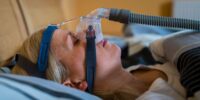How To Choose The Right Sleep Apnea Treatment Option?

Sleep apnea is a common sleep disorder that affects millions of people worldwide. Choosing the right treatment option for sleep apnea can be a daunting task, given the numerous options available.
This article aims to provide guidance on how to select the most suitable treatment option for sleep apnea. By understanding the different treatment options, assessing their effectiveness, considering personal preferences, and seeking professional advice, individuals can make an informed decision.
Additionally, researching insurance coverage and costs, as well as seeking feedback and reviews, can help individuals navigate the financial and practical aspects of treatment. Lastly, it is important to trial and adjust the chosen treatment option as needed to ensure optimal results.
By following these steps, individuals can take control of their sleep apnea management and improve their overall sleep quality and well-being.
Key Takeaways
- Understand the different treatment options available for sleep apnea, including lifestyle changes, oral appliances, CPAP therapy, and surgical interventions.
- Consider personal preferences and comfort level when choosing a treatment option, taking into account factors such as invasiveness, discomfort, and lifestyle considerations.
- Consult with a healthcare professional to determine the most appropriate course of action based on individual needs and circumstances.
- Research insurance coverage and costs to determine the most cost-effective and accessible treatment options, comparing prices, financing options, and checking for any restrictions or limitations imposed by the insurance provider.
Understand the Different Treatment Options
Understanding the various treatment options available for sleep apnea is crucial in order to make an informed decision about the most suitable approach to managing the condition.
Sleep apnea treatment options can be broadly categorized into three main types: lifestyle changes, oral appliances, and continuous positive airway pressure (CPAP) therapy.
Lifestyle changes involve adopting healthier habits such as losing weight, avoiding alcohol and sedatives, and sleeping on your side.
Oral appliances are custom-made devices worn during sleep that help keep the airway open.
CPAP therapy is the most commonly prescribed treatment and involves wearing a mask over the nose or mouth that delivers a continuous flow of air to keep the airway open.
Each treatment option has its own advantages and disadvantages, and the choice should be made based on the severity of the condition, individual preferences, and the advice of a healthcare professional.
Consider Your Comfort Level
Taking into account one’s level of comfort is essential when evaluating potential treatment methods for sleep apnea. Each individual’s comfort level may vary, and it is important to consider this factor as it can greatly impact treatment adherence and overall success.
Some treatment options, such as continuous positive airway pressure (CPAP) therapy, may involve wearing a mask during sleep, which can be uncomfortable for some individuals. However, CPAP therapy is highly effective in treating sleep apnea.
Alternatively, oral appliances can be considered for those who prefer a less invasive option. These devices are custom-made to fit the individual’s mouth and help keep the airway open during sleep.
Surgical interventions may be an option for severe cases of sleep apnea, but it is crucial to weigh the potential risks and discomfort associated with surgery.
Ultimately, prioritizing comfort and individual preferences is crucial in selecting the right sleep apnea treatment option.
Assess the Effectiveness of Each Option
Assessing the effectiveness of each treatment option involves evaluating their ability to address the symptoms and underlying causes of sleep apnea, ultimately leading to improved sleep quality and overall well-being. It is essential to consider the following factors when evaluating the effectiveness of different treatment options:
- Success Rate: Determine the percentage of individuals who have achieved significant improvement or complete resolution of their sleep apnea symptoms with a particular treatment option.
- Long-term Effects: Assess the durability of the treatment’s effects over time. Some treatments may provide immediate relief but may not be effective in the long run.
- Side Effects: Evaluate the potential adverse effects associated with each treatment option. This includes considering the risks of surgery, the inconvenience of using devices, or any discomfort caused by certain therapies.
- Patient Satisfaction: Consider the overall satisfaction of individuals who have undergone a specific treatment option. Feedback from other patients can provide valuable insights into the effectiveness and suitability of different treatments.
By carefully assessing these factors, individuals can make an informed decision and choose the most effective sleep apnea treatment option that aligns with their needs and preferences.
Consult with a Healthcare Professional
Consulting with a healthcare professional can provide valuable guidance and expertise in determining the most appropriate course of action for addressing sleep apnea. A healthcare professional can evaluate the severity of the condition, consider the patient’s overall health, and take into account individual preferences and circumstances. They can help determine whether lifestyle changes, such as weight loss or avoiding alcohol and sedatives, are sufficient or if a more intensive treatment option is necessary. Healthcare professionals can also explain the benefits and potential risks of various treatment options, such as continuous positive airway pressure (CPAP), oral appliances, or surgery. They can assess the effectiveness of each option based on scientific evidence and tailor the treatment plan to the specific needs of the patient. Ultimately, involving a healthcare professional in the decision-making process can lead to a more informed and personalized approach to treating sleep apnea.
| Pros | Cons |
|---|---|
| – Comprehensive evaluation | – Cost of treatment |
| – Expertise in sleep disorders | – Potential side effects |
| – Knowledge of treatment options | – Inconvenience of using certain devices |
| – Individualized treatment plan | – Limited availability of certain treatments |
| – Monitoring and adjustment of treatment | – Potential need for long-term commitment |
Take Your Personal Preferences into Account
When considering the right sleep apnea treatment option, it is important to take personal preferences into account.
Lifestyle considerations play a crucial role in determining the suitability of a treatment choice.
Factors such as personal tolerance and compliance also need to be evaluated to ensure the effectiveness and long-term adherence to the chosen treatment.
Lifestyle Considerations
Lifestyle considerations play a significant role in determining the most suitable sleep apnea treatment option. When choosing a treatment plan, individuals should take into account their daily routine, personal habits, and overall lifestyle. Here are some key lifestyle considerations to keep in mind:
- Sleep schedule: Treatment options may differ depending on whether an individual works night shifts or has irregular sleep patterns.
- Physical activity: Regular exercise can improve sleep quality and reduce the severity of sleep apnea symptoms. Treatment plans may incorporate exercise programs tailored to an individual’s fitness level and preferences.
- Dietary habits: Certain foods, such as those high in fat and sugar, can worsen sleep apnea symptoms. Dietary modifications, such as adopting a healthier eating pattern or avoiding specific foods, may be recommended.
- Alcohol and smoking: Both alcohol consumption and smoking can exacerbate sleep apnea. Lifestyle changes may include reducing or eliminating alcohol intake and quitting smoking.
Considering these lifestyle factors alongside personal preferences can help individuals choose a sleep apnea treatment option that is most suitable for their needs.
Personal Tolerance and Compliance
Personal tolerance and compliance are crucial factors to consider when determining the most effective approach for managing sleep apnea. It is important to assess an individual’s ability to adhere to and tolerate a particular treatment option.
Treatment options for sleep apnea include continuous positive airway pressure (CPAP) therapy, oral appliances, positional therapy, weight loss, and surgery. CPAP therapy is considered the gold standard treatment, but its effectiveness relies on patient compliance and tolerance. Some individuals may find it difficult to tolerate the CPAP device due to discomfort, claustrophobia, or skin irritation. In such cases, alternative options like oral appliances or positional therapy may be considered.
It is essential to ensure patient satisfaction and compliance with the chosen treatment option to achieve optimal outcomes in managing sleep apnea.
Research Insurance Coverage and Costs
This section will examine the importance of researching insurance coverage and costs when considering a sleep apnea treatment option.
It is essential to check your insurance policy to determine what services and treatments are covered and to what extent.
Additionally, comparing prices and financing options can help individuals make informed decisions about the most cost-effective and accessible treatment options available to them.
Check Your Insurance Policy
Checking your insurance policy is crucial when determining the most suitable sleep apnea treatment option, as it ensures the availability of coverage and financial support that may alleviate the emotional burden associated with the condition.
To begin, carefully review your insurance policy to understand the extent of coverage for sleep apnea treatments. This will help you determine the treatments that are covered and those that may require additional out-of-pocket expenses.
It is important to check if your policy covers both diagnostic tests and treatment options, including continuous positive airway pressure (CPAP) therapy, oral appliances, surgery, or other alternative therapies.
Additionally, be aware of any restrictions or limitations imposed by your insurance provider, such as pre-authorization requirements or the need for referrals from primary care physicians.
By checking your insurance policy thoroughly, you can make an informed decision about the most appropriate treatment option for your sleep apnea while considering the financial implications.
Compare Prices and Financing Options
A thorough comparison of prices and financing options allows individuals to make an informed decision regarding the most cost-effective and accessible treatment for managing sleep apnea, alleviating financial burden and providing hope for a better quality of life. When considering different sleep apnea treatment options, it is important to compare prices and financing options to ensure affordability and accessibility.
Here are three key factors to consider:
- Treatment Costs: Compare the prices of different treatment options, such as continuous positive airway pressure (CPAP) machines, oral appliances, or surgical interventions. Look for transparent pricing and consider long-term costs, including maintenance and replacement parts.
- Insurance Coverage: Check if your insurance policy covers the specific treatment option you are considering. Understand the extent of coverage, including deductibles, copayments, and out-of-pocket expenses.
- Financing Options: Investigate financing options available, such as payment plans, medical credit cards, or assistance programs. Evaluate interest rates, repayment terms, and eligibility criteria to find the best financial solution.
By carefully comparing prices and financing options, individuals can select a sleep apnea treatment that suits their budget and improves their overall well-being.
Seek Feedback and Reviews
To make an informed decision about sleep apnea treatment options, it is essential to consider seeking feedback and reviews from individuals who have undergone similar treatments. These testimonials can provide valuable insights into the effectiveness and side effects of various treatment options.
By listening to the experiences of others, individuals can gain a better understanding of what to expect during the treatment process and make more informed decisions about which option may be most suitable for their specific needs.
Feedback and reviews can be obtained from various sources, such as online forums, support groups, or healthcare professionals specializing in sleep disorders. It is important to gather information from multiple sources to ensure a comprehensive understanding of the treatment options.
Additionally, it is crucial to consider the credibility and reliability of the sources, as subjective opinions and experiences may vary.
Seeking feedback and reviews can significantly contribute to the decision-making process, providing individuals with valuable information to choose the right sleep apnea treatment option.
Trial and Adjust as Needed
Trial and adjustment of different treatment approaches is essential in order to optimize the effectiveness and minimize any potential side effects or discomfort associated with addressing sleep apnea.
Each individual may respond differently to various treatment options, so it is important to remain open to trying different approaches until the most suitable one is found.
Continuous Positive Airway Pressure (CPAP) therapy is commonly recommended as the initial treatment for sleep apnea. However, if a patient finds it uncomfortable or experiences side effects, alternative options such as oral appliances or positional therapy may be explored.
It is important to work closely with healthcare professionals to monitor treatment progress and make necessary adjustments as needed. Regular follow-up appointments and sleep studies can help gauge the effectiveness of the chosen treatment and guide any modifications required to ensure optimal outcomes for individuals with sleep apnea.
Frequently Asked Questions
Are there any natural remedies or lifestyle changes that can help with sleep apnea, in addition to medical treatments?
Natural remedies and lifestyle changes can be beneficial for managing sleep apnea in addition to medical treatments. These may include weight loss, regular exercise, avoiding alcohol and sedatives, sleeping on your side, and using nasal strips or oral appliances.
Can sleep apnea be cured completely, or is it a lifelong condition that requires ongoing treatment?
Sleep apnea is a chronic condition that typically requires ongoing treatment. While various treatment options can effectively manage the symptoms, there is currently no known cure for sleep apnea.
How long does it typically take to see improvements in sleep apnea symptoms with different treatment options?
The time it takes to see improvements in sleep apnea symptoms with different treatment options varies. Factors such as the severity of the condition, the chosen treatment method, and individual response to treatment can influence the timeframe for symptom improvement.
Are there any potential side effects or risks associated with specific sleep apnea treatments?
Potential side effects and risks vary depending on the specific sleep apnea treatment option. Continuous positive airway pressure (CPAP) may cause nasal congestion or skin irritation. Oral appliances may lead to jaw discomfort or tooth movement. Surgery carries risks such as infection or bleeding.
Can I use a combination of different treatment options to manage my sleep apnea, or is it recommended to stick to one option only?
Combining different treatment options to manage sleep apnea is a common approach. Recommendations vary based on individual needs and severity of the condition. Consulting with a healthcare professional is crucial to determine the most effective treatment plan.











